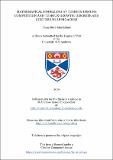Mathematical modelling of tumour-immune competition tumour growth : discrete and continuum approaches
Abstract
The ability of the human immune system to detect and remove cancer cells is exploited in the development of immunotherapy techniques. However, further understanding of these mechanisms is required and can be achieved through the use of mathematical models. In this thesis, we develop a simple individual-based model of cell movement and illustrate the ability of our model to qualitatively reproduce the migration patterns of immune cells that have been observed in single cell tracking experiments. We then extend the model to describe the spatio-temporal interactions between dendritic cells, cytotoxic T cells and a solid tumour. Through further extension of the model, we explicitly consider the immune recognition of evolving tumour antigens. Computational simulations of our models further clarify the conditions for the onset of a successful immune action against cancer cells and may suggest possible targets to improve the efficacy of immunotherapy. Mathematically, individual-based models can be limited in their amenability to different analysis techniques which are better suited to continuum models. To overcome this, we aim to derive the continuum version of our described individual-based models. However, due to the complexity of the biological mechanisms included, we first consider a simpler biological situation. We develop an individual-based model describing the spatial dynamics of multicellular systems whereby cells undergo pressure-driven movement and pressure-dependent proliferation. From this, we formally derive nonlinear partial differential equations that are commonly used to model the spatial dynamics of growing cell populations. Through systematic comparison of both models, we demonstrate that the results of computational simulations of the individual-based model faithfully mirror the qualitative and quantitative properties of the solutions to the corresponding partial differential equations. This method could be adapted to more complex individual-based models, such as those we describe in this work.
Type
Thesis, PhD Doctor of Philosophy
Rights
Creative Commons Attribution-NonCommercial-NoDerivatives 4.0 International
http://creativecommons.org/licenses/by-nc-nd/4.0/
Collections
Description of related resources
Macfarlane, F. R., Lorenzi, T., Chaplain, M. A. J. 2018. Modelling the immune response to cancer: An individual-based approach accounting for the difference in movement between inactive and activated T cells. Bull Math Biol. June 2018, 80 (6),1539-1562.Chaplain, M.A.J., Lorenzi, T. & Macfarlane, F.R. J. Math. Biol. (2019). https://doi.org/10.1007/s00285-019-01391-y
Except where otherwise noted within the work, this item's licence for re-use is described as Creative Commons Attribution-NonCommercial-NoDerivatives 4.0 International
Items in the St Andrews Research Repository are protected by copyright, with all rights reserved, unless otherwise indicated.


